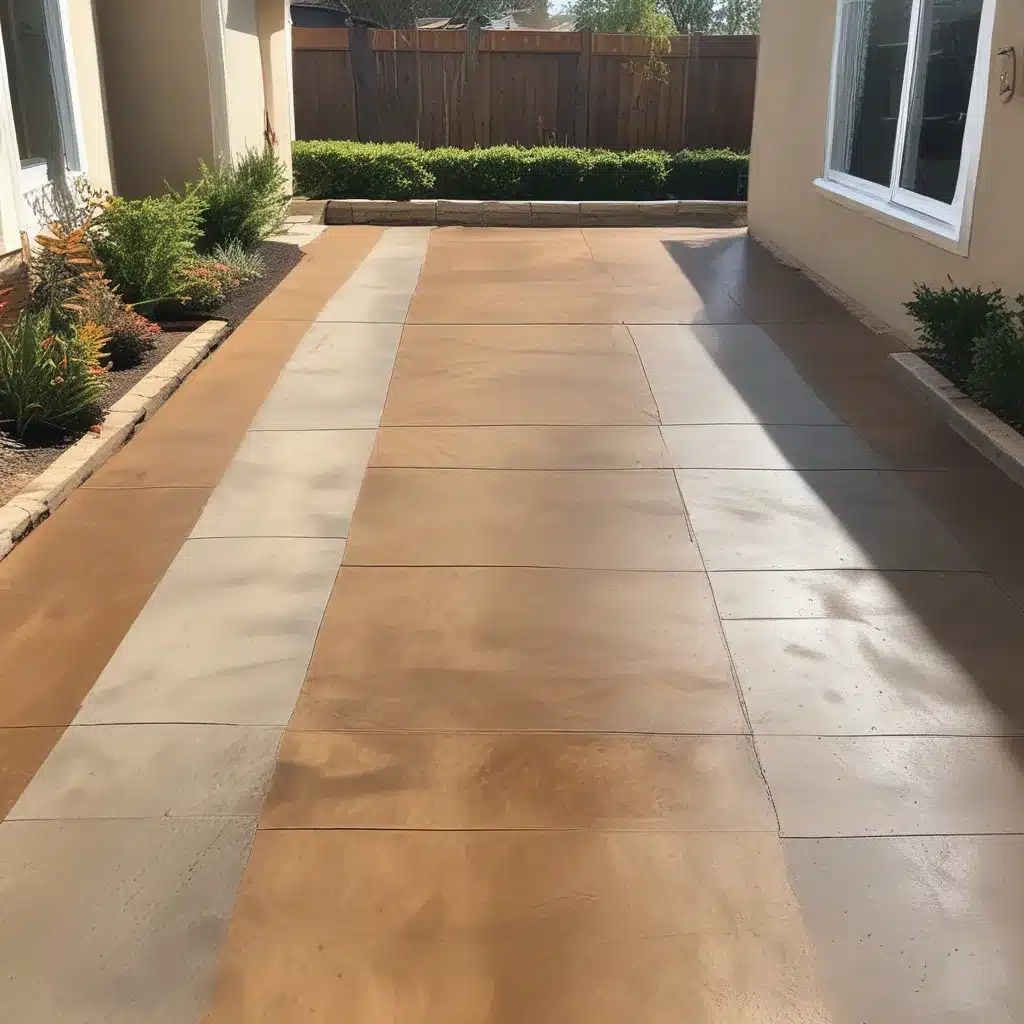
You know, I used to think concrete was just a boring, gray slab – the kind of thing you’d find in a back alley or a dimly lit parking garage. Boy, was I wrong! As it turns out, the world of concrete coloring and staining is a veritable playground for the design-savvy and the aesthetically inclined. From rich, earthy tones to vibrant splashes of color, the possibilities are endless.
Unlocking the Secrets of Concrete Staining
Let’s start with the basics, shall we? Concrete staining is the process of applying color to a concrete surface to enhance its appearance. Unlike plain old paint, which just sits on top of the surface, stains actually penetrate the concrete and react with the minerals within, creating a unique and natural-looking finish.
There are two main types of concrete stains to choose from: acid-based stains and water-based stains. Acid-based stains, as the name suggests, use an acidic solution to create a mottled, variegated look – think of rich, earthy tones that wouldn’t be out of place in a rustic Italian villa. Water-based stains, on the other hand, offer a wider range of color options and can produce both translucent and opaque finishes. And the best part? They’re more user-friendly and environmentally friendly than their acid-based counterparts.
But the benefits of concrete staining go beyond just aesthetic appeal. Concrete services like staining can also help to conceal unsightly blemishes, like cracks or discoloration, making the surface look more uniform and visually pleasing. And let’s not forget the added depth and character that a good stain can bring to a concrete surface – it’s like taking a plain old canvas and turning it into a masterpiece.
Preparing the Canvas: Cleaning and Applying the Stain
Of course, with any work of art, the preparation is key. Before you can unleash your inner Michelangelo, you’ll need to make sure the concrete surface is clean and free of any dirt, oil, or other contaminants. A good concrete cleaner and a high-powered pressure washer should do the trick.
Once the surface is spick and span, it’s time to apply the stain. And let me tell you, this is where the real fun begins. Depending on the type of stain you’re using, you’ll want to follow the manufacturer’s instructions to a T. Some stains are best applied with a sprayer, while others work better with a brush or roller. And don’t forget to start with a small test area to get the color intensity just right.
Now, here’s where things get a little tricky. If you’re using an acid-based stain, you’ll need to neutralize the surface with a baking soda and water solution once the stain has had time to work its magic. This stops the chemical reaction and prevents any unwanted discoloration.
Protecting Your Masterpiece: The Importance of Concrete Sealing
But the story doesn’t end there, my friends. Once you’ve got your concrete surface all stained and looking fabulous, you’ll want to seal it up to protect your investment. That’s where concrete sealing comes in.
A good concrete sealer serves as a protective barrier, shielding your stained surface from the ravages of abrasion, wear and tear, and even water damage. And let me tell you, a little protection goes a long way. Without a sealer, your concrete is like a priceless work of art displayed in a leaky, wind-battered gallery – it’s just not going to last.
There are a few different types of concrete sealers to choose from, each with their own unique benefits. Acrylic sealers provide a glossy finish and are available in both solvent-based and water-based formulations. Penetrating sealers, on the other hand, work by soaking into the concrete and forming a protective barrier, making them ideal for high-traffic areas. And if you really want to go all out, epoxy sealers create a thick, durable coating that’s highly resistant to chemicals, stains, and abrasion – perfect for industrial and commercial settings.
But the choice of sealer doesn’t just come down to aesthetics and durability. You’ll also need to consider the traffic and usage the concrete surface will see, as well as the local climate and weather conditions. After all, you wouldn’t want to slather your patio in a high-gloss sealer only to have it turn into a slip-and-slide every time it rains, would you?
Unleashing the Potential of Your Concrete Surfaces
So there you have it, folks – the grand unveiling of the world of concrete coloring and staining. It’s a realm where the once-humble concrete slab can be transformed into a veritable work of art, showcasing rich hues, unique textures, and a level of customization that would make even the most discerning interior designer swoon.
Whether you’re looking to breathe new life into a drab patio, create a show-stopping driveway, or add a touch of elegance to your indoor flooring, the possibilities are truly endless. And with the right concrete services and a little bit of creative flair, you can unlock the full potential of your concrete surfaces and turn them into the envy of the neighborhood.
So what are you waiting for? Grab your paintbrush (or, you know, your spray gun) and get to work! Your concrete masterpiece awaits.

